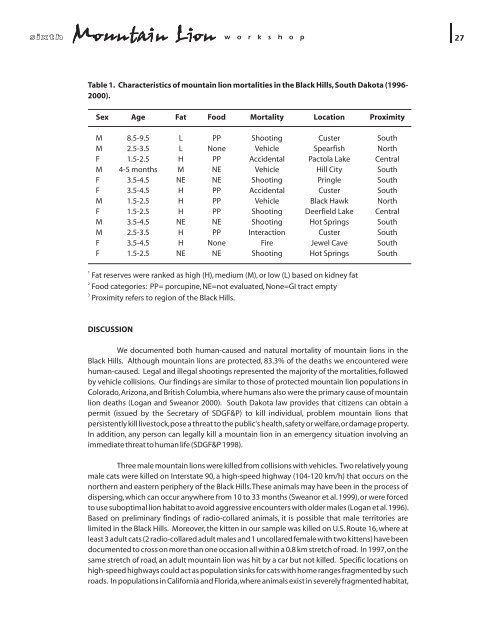PWD BK W7000-893 Proceedings.CDR - Mountain Lion Foundation
PWD BK W7000-893 Proceedings.CDR - Mountain Lion Foundation
PWD BK W7000-893 Proceedings.CDR - Mountain Lion Foundation
You also want an ePaper? Increase the reach of your titles
YUMPU automatically turns print PDFs into web optimized ePapers that Google loves.
sixth <strong>Mountain</strong> <strong>Lion</strong> w o r k s h o p 27<br />
Table 1. Characteristics of mountain lion mortalities in the Black Hills, South Dakota (1996-<br />
2000).<br />
1<br />
2<br />
3<br />
Sex Age Fat Food Mortality Location Proximity<br />
M 8.5-9.5 L PP Shooting Custer South<br />
M 2.5-3.5 L None Vehicle Spearfish North<br />
F 1.5-2.5 H PP Accidental Pactola Lake Central<br />
M 4-5 months M NE Vehicle Hill City South<br />
F 3.5-4.5 NE NE Shooting Pringle South<br />
F 3.5-4.5 H PP Accidental Custer South<br />
M 1.5-2.5 H PP Vehicle Black Hawk North<br />
F 1.5-2.5 H PP Shooting Deerfield Lake Central<br />
M 3.5-4.5 NE NE Shooting Hot Springs South<br />
M 2.5-3.5 H PP Interaction Custer South<br />
F 3.5-4.5 H None Fire Jewel Cave South<br />
F 1.5-2.5 NE NE Shooting Hot Springs South<br />
Fat reserves were ranked as high (H), medium (M), or low (L) based on kidney fat<br />
Food categories: PP= porcupine, NE=not evaluated, None=GI tract empty<br />
Proximity refers to region of the Black Hills.<br />
DISCUSSION<br />
We documented both human-caused and natural mortality of mountain lions in the<br />
Black Hills. Although mountain lions are protected, 83.3% of the deaths we encountered were<br />
human-caused. Legal and illegal shootings represented the majority of the mortalities, followed<br />
by vehicle collisions. Our findings are similar to those of protected mountain lion populations in<br />
Colorado, Arizona, and British Columbia, where humans also were the primary cause of mountain<br />
lion deaths (Logan and Sweanor 2000). South Dakota law provides that citizens can obtain a<br />
permit (issued by the Secretary of SDGF&P) to kill individual, problem mountain lions that<br />
persistently kill livestock,pose a threat to the public's health,safety or welfare,or damage property.<br />
In addition, any person can legally kill a mountain lion in an emergency situation involving an<br />
immediate threat to human life (SDGF&P 1998).<br />
Three male mountain lions were killed from collisions with vehicles. Two relatively young<br />
male cats were killed on Interstate 90, a high-speed highway (104-120 km/h) that occurs on the<br />
northern and eastern periphery of the Black Hills.These animals may have been in the process of<br />
dispersing, which can occur anywhere from 10 to 33 months (Sweanor et al. 1999), or were forced<br />
to use suboptimal lion habitat to avoid aggressive encounters with older males (Logan et al.1996).<br />
Based on preliminary findings of radio-collared animals, it is possible that male territories are<br />
limited in the Black Hills. Moreover, the kitten in our sample was killed on U.S. Route 16, where at<br />
least 3 adult cats (2 radio-collared adult males and 1 uncollared female with two kittens) have been<br />
documented to cross on more than one occasion all within a 0.8 km stretch of road. In 1997,on the<br />
same stretch of road, an adult mountain lion was hit by a car but not killed. Specific locations on<br />
high-speed highways could act as population sinks for cats with home ranges fragmented by such<br />
roads. In populations in California and Florida,where animals exist in severely fragmented habitat,
















